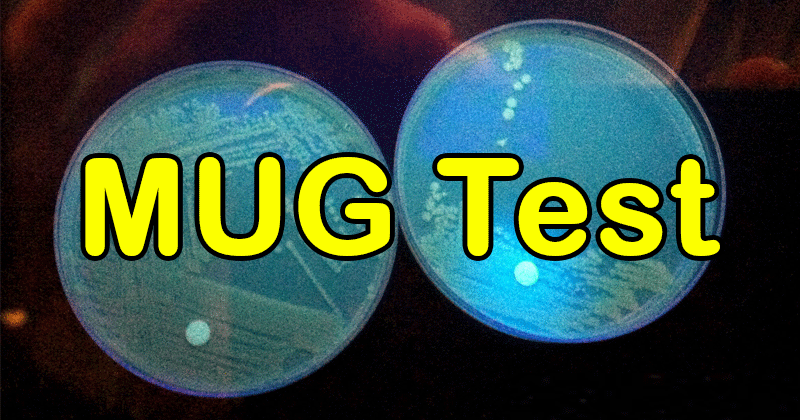Interesting Science Videos
Objective of MUG Test
To identify various genera of Enterobacteriaceae and verotoxin-producing Escherichia coli.
Principle of MUG Test
MUG is an acronym for 4-methylumbelliferyl-beta-D-glucuronide, a fluorogenic substrate of β-glucuronidase. β-D-Glucuronidase is an enzyme produced by most strains of E. coli and other Enterobacteriaceae which hydrolyzes β-d-glucopyranosid-uronic derivatives to aglycons and d-glucuronic acid. The substrate 4-methylumbelliferyl-beta-D-glucuronide is impregnated in the disc. The organism capable of producing the β- D- Glucuronidase enzyme has the ability to cleave the substrate 4- Methylumbelliferyl- β- D- Glucuronide and thereby produces a fluorescent moiety 4-methylumbelliferyl (4-MU). The end product of hydrolysis, 4-methylumbelliferyl (4-MU), fluoresces blue under long-wavelength ultraviolet light. However, verotoxin-producing strains of E. coli do not produce MUG, and a negative test result may indicate the presence of a clinically important strain. 4-MU fluorescence is pH-dependent with excitation maxima of 320 and 360 nm at low (1.97-6.72) and high (7.12-10.3) pH, respectively.
Procedure of MUG Test
Direct disk test
- Place a MUG disk in an empty sterile petri dish and add a drop of demineralized water.
- Smear 2-3 isolated colonies from 18-24 hour old culture on the disk.
- Place a piece of filter paper saturated with water in the lid of the petri dish to provide humid environment.
- Incubate aerobically at 35°-37°C for up to 30 minutes.
- Following incubation, examine the disk for fluorescence using longwave ultraviolet light (360nm) in a darkened room.
Tube test
- Add 0.25ml of demineralized water to a clean glass tube.
- Make a heavy suspension with 3- 4 colonies of test isolate in the tube.
- Using forcep, place a MUG disk in the tube and shake vigorously to ensure adequate elution of substrate in the surrounding liquid.
- Incubate aerobically at 35°-37°C for up to 1 hour.
- Following incubation, examine the disk for fluorescence using longwave ultraviolet light (360nm) in a darkened room.
Result Interpretation of MUG Test

Positive test: blue fluorescence
Negative test: no fluorescence
Limitations of MUG Test
- This test is only part of the overall scheme for identification of E. coli. Further biochemical and serological testing is required for definitive identification.
- Most strains of E. coli 0157:H7 are MUG negative. The use of an E. coli 0157:H7 latex agglutination test in conjunction with the MUG test is recommended for rapid identification of isolates during outbreaks.
- Some strains of Shigella are MUG positive. Serological testing may be required to differentiate Shigella and E. coli.
- False negative reactions may be reported when test colonies isolated from medias containing dyes (EMB, MAC) are used and hence it may make the interpretation difficult.
- Organisms other than E. coli like Salmonella, Shigella, Staphylococcus, Streptococcus possess the enzyme β-Glucuronidase and are MUG positive. Testing only lactose positive, gram negative rods for β – Glucuronidase activity helps preclude misidentification of other organisms as E. coli.
Quality Control of MUG Test
Positive: Escherichia coli (ATCC25922)
Negative: Klebsiella pneumoniae (ATC13883)
References
- Tille P.M. 2014. Bailey and Scott’s diagnostic microbiology. Thirteen edition. Mosby, Inc., an affiliate of Elsevier Inc. 3251 Riverport Lane. St. Louis. Missouri 63043
- Remel MUG disk. 2010. 12076 Santa Fe Drive, Lenexa, KS 66215, USA https://assets.thermofisher.com/TFS-Assets/LSG/manuals/IFU21135.pdf

MUG test photo credit to: https://xiaohuilau.com/2015/09/lets-take-a-mug-shot/
Hi,
Thanks for the update and sorry that we missed giving credit. We have added the reference/credit to the image.